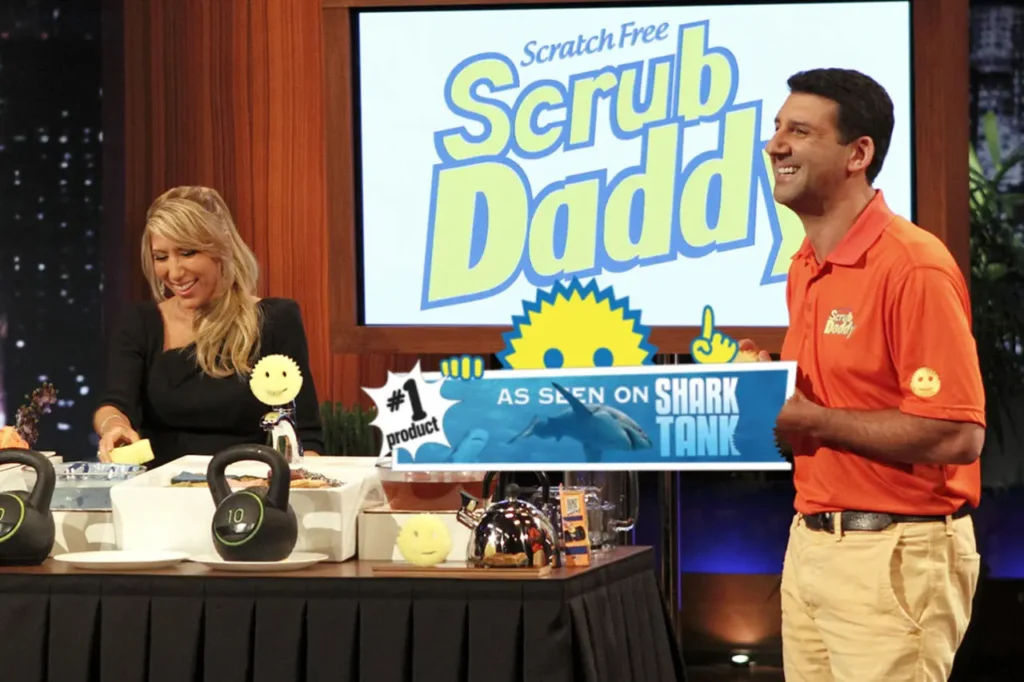Let us talk about the episode of Shark Tank and the Scrub Daddy and dig deep into marketing lessons from Shark Tank. It was one of the best examples of a product that could make or break even something as extraordinary as Scrub Daddy via marketing.
Scrub Daddy on Shark Tank
Aaron didn’t just sell the sponge. He sold the essence of getting a revolutionary product that could simplify people’s lives and make cleaning a little more bearable. Positioning Scrub Daddy as a life-changer, possibly a better example of putting out the audience feeling is preparing the explosion that follows by teasing a demonstration and a very engaging one at that. Live in action—showing the transformation of the sponge by pouring hot water over it—was very convincing. It’s not just showing what the product does exist, but also how it lies, which for now involves innovation meeting functionality. That is the revelation of this innovative marketing tool that, for now, will make your product a must-have.

Short, concise, and clear pitching with a punch was Aaron’s style. It wasn’t all about numbers; it was about establishing the value of the product in the first person. A lot of marketers know you can do a better job hooking your consumer’s heart than with logic alone. That “smiling face” design made the product instantly relatable and memorable. Just this little touch, in a sense, was plain; it was more character. The consumer could connect with something.
It has already amounted to $100,000 in revenue from QVC. His belief in the brand and its scalability gave him a clear vision of where he wanted to go next—manufacturing on a larger scale. From a marketing perspective, the consistency in his message—Scrub Daddy is not just a novelty but a practical solution for everyday cleaning—was spot on.
Marketing lessons from Shark Tank
This figure alone will astound you: 6 billion people worldwide have mobile phones, while only 4.5 billion have access to toilets. That is more smartphones than toilets; it is, in itself, a paradox. And that is what we are going to take advantage of. You just need to know how to apply the principles of the most effective marketing for you.
Step 1: Define Your Offer
The one thing that differentiates this marketing campaign from the others is to have your branding in place. This is the foundation on which all the campaigns revolve. Whether you are in the process of starting a new business or upscaling an old one, have clear, desirable, and invaluable branding to the target market.
Now comes the disputable point: Is it better to start with the market or to carve out an offer? We suggest that if anything is to be done for the first time, it is much better if one first understands the needs and pain areas of the target market. For nothing is ever understood fully unless it is properly perceived, and the more one knows and discovers of the problems of his customer, the easier it will be for him to be an expert in telling how his offer addresses these problems.
Step 2: Setting Clear Goals
Once you have your product ready, it’s time to figure out your goals. Think of these goals as your roadmap—they guide where you want to go with your marketing efforts.
Your goals don’t always have to be overly specific or filled with complicated numbers like “increase acquisition by 3%.” What matters most is having a clear sense of direction. Ask yourself: What is the purpose of your marketing? What do you want to achieve?
Whether it’s building brand awareness, boosting sales, or generating leads, having well-defined goals ensures that every marketing decision you make aligns with your overall objectives.
Step 3: Know Your Audience Inside and Out
Each person intended for a marketing program should be individually identified. The message will indicate a marketing campaign that is truly a hit and resonates with the core of an ideal target market’s needs, fears, and pain points. What are the needs of the ideal buyer? What does the ideal buyer want? How can these problems be solved?

Afterwards, and lastly, this method will help you focus your efforts, rather than throwing them to the wind doing a lot of everything in the marketing process, translating it into the specific content directed towards the exact person that impacts your industry.
Step 4: Create a Convincing Message
Scrub Daddy markets itself as one big fun all along the way while serving the practical cleaning aid. It’s not just a smiley-faced sponge that is attractive; it is a cleaning utility sponge built especially for rough and disordered conditions with an assurance that it will not scratch surfaces. By highlighting certain features like the change in texture with water temperature, ergonomic configuration, and the like, it makes Scrub Daddy the go-to cleaning solution for pleasurable and enjoyable cleaning application.
This marketing message scores 10/10 for clarity, relevance, and emotional appeal.
Step 5: Choose the Right Marketing Channels
Now that you have your offer, goals, audience, and message, it’s time to choose the right channels for your marketing. Whether it’s social media, email marketing, paid ads, or content marketing, each channel has its strengths and weaknesses. The key is to choose the ones that best suit your audience and goals.
For example, if you’re targeting younger consumers, Instagram and TikTok might be the best platforms for reaching them. If you’re focusing on a more professional audience, LinkedIn might be your best bet. By carefully selecting the right channels, you ensure that your message reaches the right people in the right place.
Step 6: Test, Analyze, and Adjust
Marketing is never a set-it-and-forget-it process. You need to constantly test your strategies, analyze the results, and adjust your approach accordingly. Look at your analytics, gather feedback from your customers, and see what’s working—and what’s not. Use this information to refine your marketing tactics over time.
Shark Tank marketing involves showcasing a product’s value through strong storytelling, live demonstrations, and highlighting unique features to connect with both investors and consumers effectively.
Around 50%–60% of Shark Tank deals succeed post-show. Many deals undergo renegotiation, and not all close after airing due to due diligence or strategy changes.
The Scrub Daddy is often considered the most successful Shark Tank product, generating millions in sales with its innovative design, clever branding, and universal appeal.



